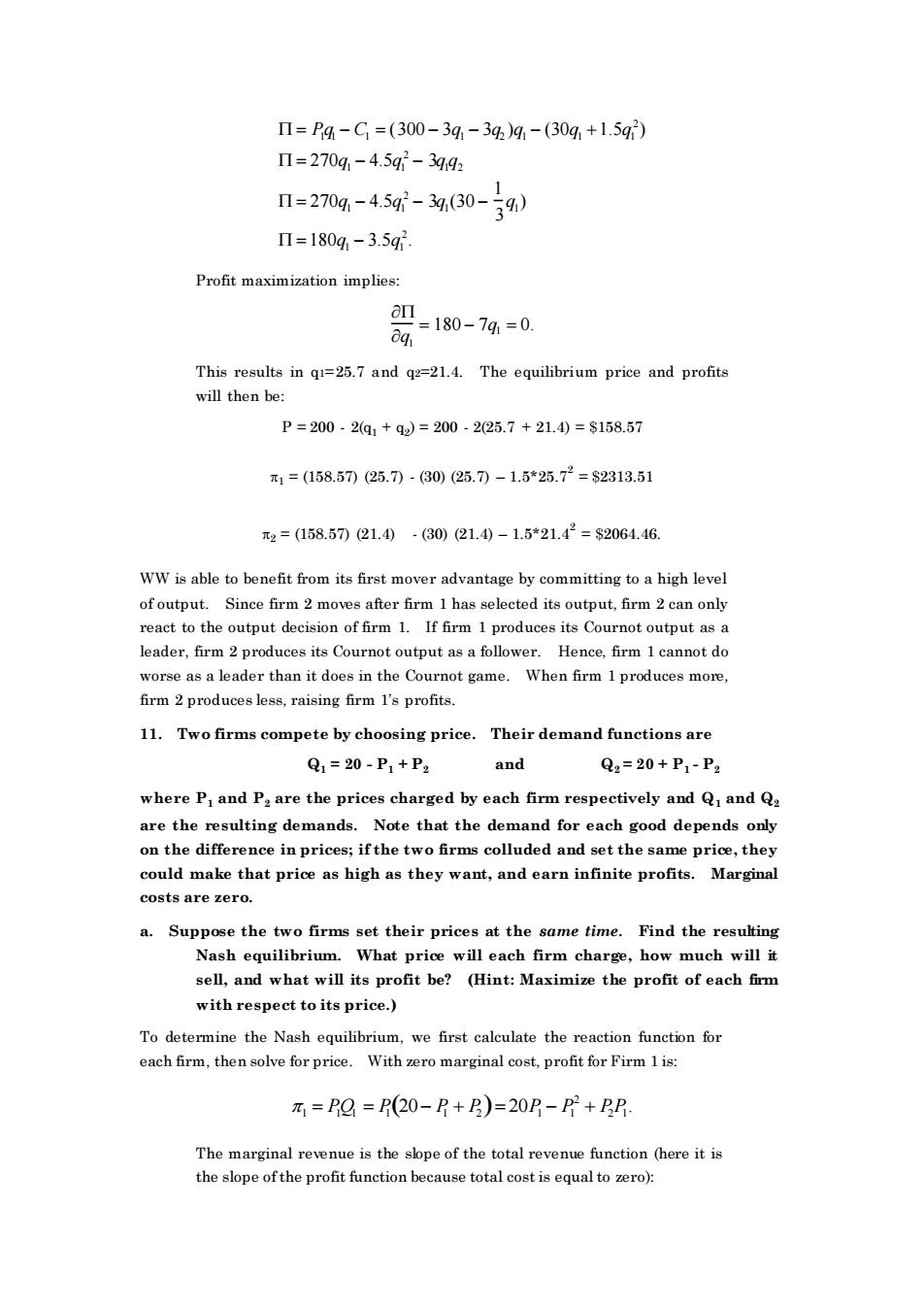正在加载图片...

Π=P4-C=(300-3q,-34)4-(30g+1.5g) Π=2704,-4.5q2-3q,92 1=270g-45g-3g(30-59) Π=180g,-3.5q Profit maximization implies: a0=180-74=0, This results in q=25.7 and q2=21.4.The equilibrium price and profits will then be P=200-2g1+9)=200-225.7+21.40=$158.57 1=(158.57)(25.7)-80)(25.7-1.5*25.72=$2313.51 2=(158.57(21.4)-(30)(21.4)-1.5*21.4=$2064.46. WW is able to benefit from its first mover advantage by committing to a high level of output.Since firm 2 mo out,firm 2 can only the If firm 1 arnot output as leader,firm 2 produces its Cournot output as a follower.Hence,firm 1 cannot de worse as a leader than it does in the Cournot game.When firm 1 produces more. firm 2 produces less,raising firm I's profits. 11.Two firms compete by choosing price.Their demand functions are Q1=20-P1+P2 and Q2=20+P1-P2 where P and P:are the prices charged by each firm respectively and Q and Q are the resulting demands.Note that the demand for each good depends ony on the difference in prices;ifthe s colluded and s set th e sa e price,the could make that price as high as they want,and earn infinite profits.Marginal costs are zero. a.Suppose the two firms set their prices at the same time.Find the resulting Nash equilibrium.What price will each firm charge,how much will it sell,and what will its profit be?(Hint:Maximize the profit of each firm with respect to its price.) To determine the Nash equilibrium,we first calculate the on function for each firm,thensolve for price.cost profit for Firm1is =PO=P(20-P+R)=20P-P+PP The marginal revenue is the sbpe of the total revenue function (here it is the slope of the profit function because total cost is equal to zero): = P1q1 − C1 = (300 − 3q1 − 3q2 )q1 − (30q1 +1.5q1 2 ) = 270q1 − 4.5q1 2 − 3q1q2 = 270q1 − 4.5q1 2 − 3q1 (30 − 1 3 q1 ) =180q1 − 3.5q1 2 . Profit maximization implies: q1 = 180 − 7q1 = 0. This results in q1=25.7 and q2=21.4. The equilibrium price and profits will then be: P = 200 - 2(q1 + q2 ) = 200 - 2(25.7 + 21.4) = $158.57 1 = (158.57) (25.7) - (30) (25.7) – 1.5*25.72 = $2313.51 2 = (158.57) (21.4) - (30) (21.4) – 1.5*21.42 = $2064.46. WW is able to benefit from its first mover advantage by committing to a high level of output. Since firm 2 moves after firm 1 has selected its output, firm 2 can only react to the output decision of firm 1. If firm 1 produces its Cournot output as a leader, firm 2 produces its Cournot output as a follower. Hence, firm 1 cannot do worse as a leader than it does in the Cournot game. When firm 1 produces more, firm 2 produces less, raising firm 1’s profits. 11. Two firms compete by choosing price. Their demand functions are Q1 = 20 - P1 + P2 and Q2 = 20 + P1 - P2 where P1 and P2 are the prices charged by each firm respectively and Q1 and Q2 are the resulting demands. Note that the demand for each good depends only on the difference in prices; if the two firms colluded and set the same price, they could make that price as high as they want, and earn infinite profits. Marginal costs are zero. a. Suppose the two firms set their prices at the same time. Find the resulting Nash equilibrium. What price will each firm charge, how much will it sell, and what will its profit be? (Hint: Maximize the profit of each firm with respect to its price.) To determine the Nash equilibrium, we first calculate the reaction function for each firm, then solve for price. With zero marginal cost, profit for Firm 1 is: 1 = P1Q1 = P1 20− P1 + P2 ( )= 20P1 − P1 2 + P2P1 . The marginal revenue is the slope of the total revenue function (here it is the slope of the profit function because total cost is equal to zero):